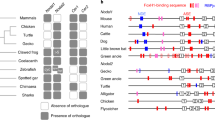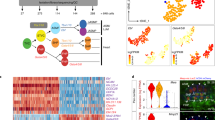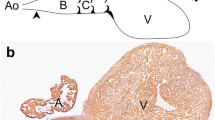Abstract
The emergence of terrestrial life witnessed the need for more sophisticated circulatory systems. This has evolved in birds, mammals and crocodilians into complete septation of the heart into left and right sides, allowing separate pulmonary and systemic circulatory systems, a key requirement for the evolution of endothermy1,2,3. However, the evolution of the amniote heart is poorly understood. Reptilian hearts have been the subject of debate in the context of the evolution of cardiac septation: do they possess a single ventricular chamber or two incompletely septated ventricles4,5,6,7? Here we examine heart development in the red-eared slider turtle, Trachemys scripta elegans (a chelonian), and the green anole, Anolis carolinensis (a squamate), focusing on gene expression in the developing ventricles. Both reptiles initially form a ventricular chamber that homogenously expresses the T-box transcription factor gene Tbx5. In contrast, in birds and mammals, Tbx5 is restricted to left ventricle precursors8,9. In later stages, Tbx5 expression in the turtle (but not anole) heart is gradually restricted to a distinct left ventricle, forming a left–right gradient. This suggests that Tbx5 expression was refined during evolution to pattern the ventricles. In support of this hypothesis, we show that loss of Tbx5 in the mouse ventricle results in a single chamber lacking distinct identity, indicating a requirement for Tbx5 in septation. Importantly, misexpression of Tbx5 throughout the developing myocardium to mimic the reptilian expression pattern also results in a single mispatterned ventricular chamber lacking septation. Thus ventricular septation is established by a steep and correctly positioned Tbx5 gradient. Our findings provide a molecular mechanism for the evolution of the amniote ventricle, and support the concept that altered expression of developmental regulators is a key mechanism of vertebrate evolution.
This is a preview of subscription content, access via your institution
Access options
Subscribe to this journal
Receive 51 print issues and online access
$199.00 per year
only $3.90 per issue
Buy this article
- Purchase on Springer Link
- Instant access to full article PDF
Prices may be subject to local taxes which are calculated during checkout




Similar content being viewed by others
References
Farmer, C. G. Evolution of the vertebrate cardio-pulmonary system. Annu. Rev. Physiol. 61, 573–592 (1999)
Hillenius, W. J. & Ruben, J. A. The evolution of endothermy in terrestrial vertebrates: Who? When? Why? Physiol. Biochem. Zool. 77, 1019–1042 (2004)
Olson, E. N. Gene regulatory networks in the evolution and development of the heart. Science 313, 1922–1927 (2006)
Holmes, E. B. A reconsideration of the phylogeny of the tetrapod heart. J. Morphol. 147, 209–228 (1975)
Webb, G. J. W. Comparative cardiac anatomy of the Reptilia. III. The heart of crocodilians and an hypothesis on the completion of the interventricular septum of crocodilians and birds. J. Morphol. 161, 221–240 (1979)
Farrell, A. P., Gamperl, A. K. & Francis, E. T. B. in Biology of the Reptilia Vol. 19 (eds Gans, C. & Gaunt, A. S.) 375–424 (Society for the Study of Amphibians and Reptiles, 1998)
Hicks, J. W. The physiological and evolutionary significance of cardiovascular shunting patterns in reptiles. News Physiol. Sci. 17, 241–245 (2002)
Bruneau, B. G. et al. Chamber-specific cardiac expression of Tbx5 and heart defects in Holt–Oram syndrome. Dev. Biol. 211, 100–108 (1999)
Takeuchi, J. K. et al. Tbx5 specifies the left/right ventricles and ventricular septum position during cardiogenesis. Development 130, 5953–5964 (2003)
Seymour, R. S. et al. Evidence for endothermic ancestors of crocodiles at the stem of archosaur evolution. Physiol. Biochem. Zool. 77, 1051–1067 (2004)
Greil, A. Beitrage zur vergleichenden Anatomie und Entwicklungsgeschichte des Herzens und des Truncus arteriosus der Wirbeltiere. Morphol. Jahrb. 31, 123–310 (1903)
Stennard, F. A. & Harvey, R. P. T-box transcription factors and their roles in regulatory hierarchies in the developing heart. Development 132, 4897–4910 (2005)
Horb, M. E. & Thomsen, G. H. Tbx5 is essential for heart development. Development 126, 1739–1751 (1999)
Bruneau, B. G. et al. A murine model of Holt–Oram syndrome defines roles of the T-box transcription factor Tbx5 in cardiogenesis and disease. Cell 106, 709–721 (2001)
Bruneau, B. G. The developmental genetics of congenital heart disease. Nature 451, 943–948 (2008)
Mori, A. D. et al. Tbx5-dependent rheostatic control of cardiac gene expression and morphogenesis. Dev. Biol. 297, 566–586 (2006)
Koshiba-Takeuchi, K. et al. Cooperative and antagonistic interactions between Sall4 and Tbx5 pattern the mouse limb and heart. Nature Genet. 38, 175–183 (2006)
Rieppel, O. Turtle origins. Science 283, 945–946 (1999)
Lyson, T. & Gilbert, S. F. Turtles all the way down: loggerheads at the root of the chelonian tree. Evol. Dev. 11, 133–135 (2009)
Hedges, S. B. & Poling, L. L. A molecular phylogeny of reptiles. Science 283, 998–1001 (1999)
Shedlock, A. M. et al. Phylogenomics of nonavian reptiles and the structure of the ancestral amniote genome. Proc. Natl Acad. Sci. USA 104, 2767–2772 (2007)
Chen, H. et al. BMP10 is essential for maintaining cardiac growth during murine cardiogenesis. Development 131, 2219–2231 (2004)
Trajanovska, S. & Donald, J. A. Molecular cloning of natriuretic peptides from the heart of reptiles: loss of ANP in diapsid reptiles and birds. Gen. Comp. Endocrinol. 156, 339–346 (2008)
McFadden, D. G. et al. The Hand1 and Hand2 transcription factors regulate expansion of the embryonic cardiac ventricles in a gene dosage-dependent manner. Development 132, 189–201 (2004)
Verzi, M. P. et al. The right ventricle, outflow tract, and ventricular septum comprise a restricted expression domain within the secondary/anterior heart field. Dev. Biol. 287, 437–449 (2005)
Georges, R. et al. Distinct expression and function of alternatively spliced Tbx5 isoforms in cell growth and differentiation. Mol. Cell. Biol. 28, 4052–4067 (2008)
Carroll, S. B. Evo-devo and an expanding evolutionary synthesis: a genetic theory of morphological evolution. Cell 134, 25–36 (2008)
Lickert, H. et al. Baf60c is essential for function of BAF chromatin remodelling complexes in heart development. Nature 432, 107–112 (2004)
Greenbaum, E. & Carr, J. L. Staging criteria for embryos of the spiny softshell turtle, Apalone spinifera (Testudines: Trionychidae). J. Morphol. 254, 272–291 (2002)
Sanger, T. J., Losos, J. B. & Gibson-Brown, J. J. A developmental staging series for the lizard genus Anolis: a new system for the integration of evolution, development, and ecology. J. Morphol. 269, 129–137 (2008)
Acknowledgements
We thank J. N. Wylie and L. Davidson for technical assistance, M. Harris and J. Fallon for alligator embryos, T. Sanger and J. Gibson-Brown for unpublished data on Anolis staging, T. Ogura for chick Tbx5 and Tbx20 probes, and G. Howard and S. Ordway for editorial assistance. This work was funded in part by the March of Dimes Birth Defects Foundation (B.G.B.), the J. David Gladstone Institutes (B.G.B.), William H. Younger Jr (B.G.B.); a National Institutes of Health program project grant (P01HL089707 to B.G.B., B.L.B.); scholarships from the Natural Sciences and Engineering Research Council of Canada, the Heart and Stroke Richard Lewar Centre for Excellence, University of Toronto, and Ontario Graduate Scholarship (A.D.M.); the Fumi Yamamura Memorial Foundation for Female Natural Scientists and Grants-in-Aid for Scientific Research (C) (K.K.-T.), MEXT’s program for young independent researchers (K.K.-T., J.K.T.), Sumitomo Foundation and Nakajima Foundation (J.K.T.), a Canada Research Chair in Imaging (R.M.H.), the Heart and Stroke foundation of Canada and the Canadian Institutes for Health Research (M.N.), and grants from the National Science Foundation (RUI-0748508 to S.F.G., J.C.-T. and IOS-0742833 to J.W.). Funding for the J. David Gladstone Institutes from a National Institutes of Health/ National Center for Research Resources grant (C06 RR018928) is also acknowledged.
Author Contributions K.K.-T. performed reptile histology and gene expression studies; A.D.M., B.L.K., T.S. and B.G.B. performed mouse experiments; J.C.-T. and S.F.G. obtained turtle specimens and isolated T. scripta Tbx5 complementary DNA (cDNA); S.L. and L.B. isolated Anolis specimens under direction of J.W.; B.L.K. acquired and reconstructed OPT images; R.O.G. performed Tbx5 immunohistochemistry under direction of M.N.; R.M.H. directed initial mouse embryo OPT; J.K.T. obtained chick and mouse specimens; R.O.G., M.N., B.L.B. and E.N.O. provided genetically modified mice before publication; B.G.B. conceived and directed the project, and wrote the paper. All authors contributed to the written manuscript.
Author information
Authors and Affiliations
Corresponding author
Supplementary information
Supplementary Information
This file contains Supplementary Notes, Supplementary References and Supplementary Figures 1-9 with Legends. (PDF 4459 kb)
Rights and permissions
About this article
Cite this article
Koshiba-Takeuchi, K., Mori, A., Kaynak, B. et al. Reptilian heart development and the molecular basis of cardiac chamber evolution. Nature 461, 95–98 (2009). https://doi.org/10.1038/nature08324
Received:
Accepted:
Issue Date:
DOI: https://doi.org/10.1038/nature08324
This article is cited by
-
Developmental heart morphology in the Amazon turtle Podocnemis expansa (Testudines: Podocnemidae)
Zoomorphology (2023)
-
Single ventricle: amphibians and human beings
World Journal of Pediatrics (2022)
-
A comparative analysis of heart microRNAs in vertebrates brings novel insights into the evolution of genetic regulatory networks
BMC Genomics (2021)
-
Cardiac natriuretic peptides
Nature Reviews Cardiology (2020)
-
In vitro generation of functional murine heart organoids via FGF4 and extracellular matrix
Nature Communications (2020)
Comments
By submitting a comment you agree to abide by our Terms and Community Guidelines. If you find something abusive or that does not comply with our terms or guidelines please flag it as inappropriate.



